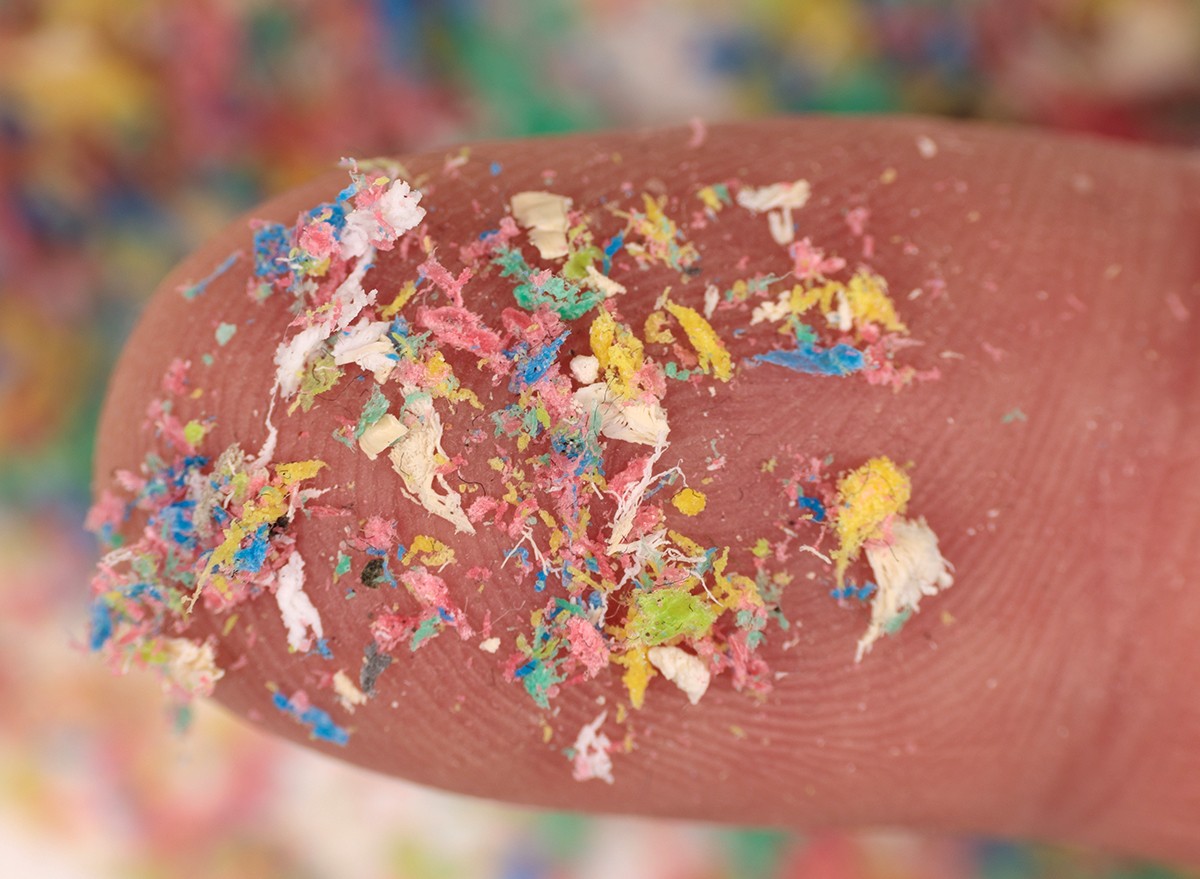A Spoonful of Microplastics Could Be Stuck in Your Brain, Disturbing New Study Finds

The evidence of the harmful effects of using plastic in our everyday lives is mounting. A disturbing new study has revealed an increase in micro- and nanoplastics in human brains, with levels 50% higher than those previously observed in 2016—equalling the size of an entire plastic spoon.
Researchers from the University of New Mexico analyzed brain samples from recent autopsies and found that plastic particles are accumulating in human tissue at an alarming rate. Since their presence has been linked to strokes, heart attacks, and other harmful effects, here’s what the latest science is saying—and how you can keep yourself healthy.
RELATED: Our Oceans Are Turning Into Plastic…Are We?
Plastic in the Brain: A Growing Concern
The new study, published Monday in the journal Nature Medicine, examined tissue samples from the brains, livers, and kidneys of 28 subjects who died in 2016, and compared them to those of 24 individuals who died in 2024 (all of whom lived in New Mexico).
Levels of microplastics were highest in the brain tissue, which was taken from the frontal cortex linked to thinking and reasoning. Elevated levels of microplastics were also seen in the brain and liver samples from 2024 compared to 2016.
“The concentrations we saw in the brain tissue of normal individuals were 4,800 micrograms per gram, or 0.48% by weight—the equivalent of a standard plastic spoon,” said study co-author Matthew Campen, a professor of pharmaceutical sciences at the University of New Mexico.
When comparing the brain tissue samples from previous ones taken from those who died between 1997 and 2013, the results showed microplastic contamination in the brains of Americans is increasing over time at an alarming rate.
In fact, the latest 2024 samples showed that the brain contained 7-30 times more plastic than the liver and kidneys, raising questions about whether the brain has the ability to effectively clear some of these unnatural particles. (The liver and kidneys shows some signs of flushing microplastics from their system, the study authors said.)
While the study was small, these findings are startling and suggest that “our brains today are 99.5% brain and the rest is plastic,” Campen said.
How Are Microplastics Entering the Brain and Body?
Particles smaller than you can see, about 200 nanometers or less, from everyday items like plastic bags and food and drink packaging may be slipping past our blood-brain barriers by attaching to dietary fats, scientists hypothesize.
“One theory is that plastics are hitching a ride with the fats we eat, which are then delivered to the organs that really like lipids—the brain is top among those,” Campen explained.
It seems no human organs are immune to these unwelcome visitors.
Previous research has found microplastics present in the heart, liver, lungs, blood vessels, and even reproductive organs of study subjects, pediatrician and biology professor Dr. Philip Landrigan, director of the Program for Global Public Health and the Common Good and the Global Observatory on Planetary Health at Boston College, told CNN.
“The biggest question is, ‘OK, what are these particles doing to us?’ Honestly there’s a lot we still don’t know,” Dr. Landrigan said. “What we do know with real certainty is that these microplastic particles are like Trojan horses—they carry with them all the thousands of chemicals that are in plastics and some of these chemicals are very bad actors.”
What Does This Mean for Your Health?

The new study published Monday also found three to five times more plastic fragments in the brains of 12 subjects diagnosed with dementia compared to those without the disease.
The plastic particles were found in their brain arteries, veins, and immune cells, however, study author Campen said that this cannot be confused with causation.
“It’s a little bit alarming, but remember that dementia is a disease where the blood-brain barrier and clearance mechanisms are impaired,” Campen said. “We want to be very cautious in interpreting these results as the microplastics are very likely elevated because of the disease (dementia), and we do not currently suggest that microplastics could cause the disease.”
Still, experts like Dr. Landrigan are stating that, while there’s a lot the scientific community does not yet know about the health impacts of microplastics, there is enough evidence to suggest that these foreign objects—and the chemicals within them—are causing us harm.
“I would say we have enough information here that we need to start taking protective action,” he told CNN.
RELATED: Groundbreaking New Study Shows How Much Plastic Is In Water Bottles
How to Reduce Your Exposure to Microplastics
While major manufacturers have no plans to slow the rise of their plastic production, there are small but impactful steps you can take in your daily routine to reduce your use of potentially harmful plastics.
For starters, use reusable or cloth bags instead of plastic bags when shopping. Bring your own produce pouches and grocery bags whenever you’re shopping for food. Buying in bulk using your own containers or bags can cut plastic packaging waste by up to 80%, research has found.
Prep and store food glass or ceramic containers. When heating up food, do not place plastic in the microwave. Transfer it to a paper or ceramic dish or bowl, then pop it in.
Use a refillable glass, ceramic, or aluminum water bottle and commit to never using bottled water again, unless it’s your only option. A 2024 study found that one liter of bottled water contains an average of 240,000 plastic particles. In the same vein, ditch plastic utensils and straws, too.
When shopping for new personal care or home products, opt for brands that have sustainable and eco-friendly packaging. For instance, bar soaps, bamboo toothbrushes, and refillable cosmetics significantly reduce plastic waste.
Finally, do your part by supporting legislation that aims to reduce or ban single-use plastics and companies that are committed to sustainable, plastic-free practices.
By making these small shifts, you can shrink your own daily exposure to plastic.